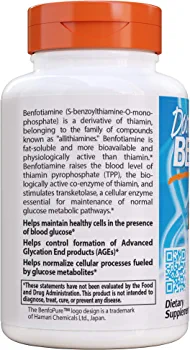This product, Benfotiamine, is designed to increase the levels of thiamine pyrophosphate (TPP) in the blood. TPP is an essential co-enzyme for thiamine (vitamin B1) and plays a crucial role in glucose metabolism. The enzymatic addition of two phosphate groups donated by ATP to thiamine forms TPP, also known as thiamine diphosphate. Glucose is metabolized to pyruvic acid in the cytoplasm of the cell, which is then converted into acetyl-CoA, the primary fuel for the Krebs cycle in the mitochondrion. TPP is essential for the removal of CO2 from pyruvic acid, which is a key step in the conversion of pyruvic acid to acetyl CoA. Benfotiamine helps maintain healthy cells in the presence of blood glucose by normalizing cellular processes fueled by glucose metabolites. It prevents the accumulation of excess glucose metabolites within the cell and ensures that the bulk of the cell’s glucose supply is converted to pyruvic acid, which serves as a substrate for the production of acetyl CoA. The Krebs cycle generates about 90 percent of the total amount of metabolic energy (in the form of ATP) released from food.
| Region | American |
|---|---|
| Brand | |
| URL | |
| priceOriginal | MULTIPLE |
| categories | Health & Household |
| sub_Categories | Vitamins, Minerals & Supplements, Blended Vitamin & Mineral Supplements |
| nameOriginal | Doctor's Best Benfotiamine, Non-GMO, Vegan, Gluten Free, Soy Free, Helps Maintain Blood Sugar Levels, 300 mg, 60 Veggie Caps (DRB-00270) |
| descriptionOriginal | Description Benfotiamine raises the blood level of thiamine pyrophosphate (TPP), the biologically active co-enzyme of thiamine. Thiamine and its co-enzyme, TPP thiamine (vitamin B1) plays an essential part in the metabolism of glucose, through actions of it co-enzyme TPP (thiamine pyrophosphate). TPP is formed by the enzymatically catalyzed addition of two phosphate groups donated by ATP to thiamine. TPP also goes by the name thiamine diphosphate. In the cytoplasm of the cell, glucose, a 6-carbon sugar, is metabolized to pyruvic acid, which is converted into acetyl-CoA, otherwise known as active acetate. Acetyl CoA enters the mitochondrion, where it serves as the starting substrate in the Kreb's cycle citric acid cycle. The Krebs cycle is the primary source of cellular metabolic energy. TPP, along with other co-enzymes, is essential for the removal of CO2 from pyruvic acid, which in turn is a key step in the conversion of pyruvic acid to acetyl CoA. CO2 removal from pyruvic acid is called oxidative decarboxylation and for this reason, TPP was originally referred to as cocarboxylase. TPP is thus vital to the cell's energy supply. Benfotiamine helps maintain healthy cells in the presence of blood glucose. Acting as a biochemical super-thiamin, it does this through several different cellular mechanisms, as discussed below. Benfotiamine and glucose metabolism benfotiamine normalizes cellular processes fueled by glucose metabolites. As long as glucose remains at normal levels, excess glucose metabolites do not accumulate within the cell. The bulk of the cell's glucose supply is converted to pyruvic acid, which serves as substrate for production of acetyl CoA, the primary fuel for the krebs cycle. Of the total amount of metabolic energy (in the form of ATP) released from food, the Krebs cycle generates about 90 percent. |
| ETA | 21 days |
| PPN | 685310955875 |
| ETAKSA | 9 days |








